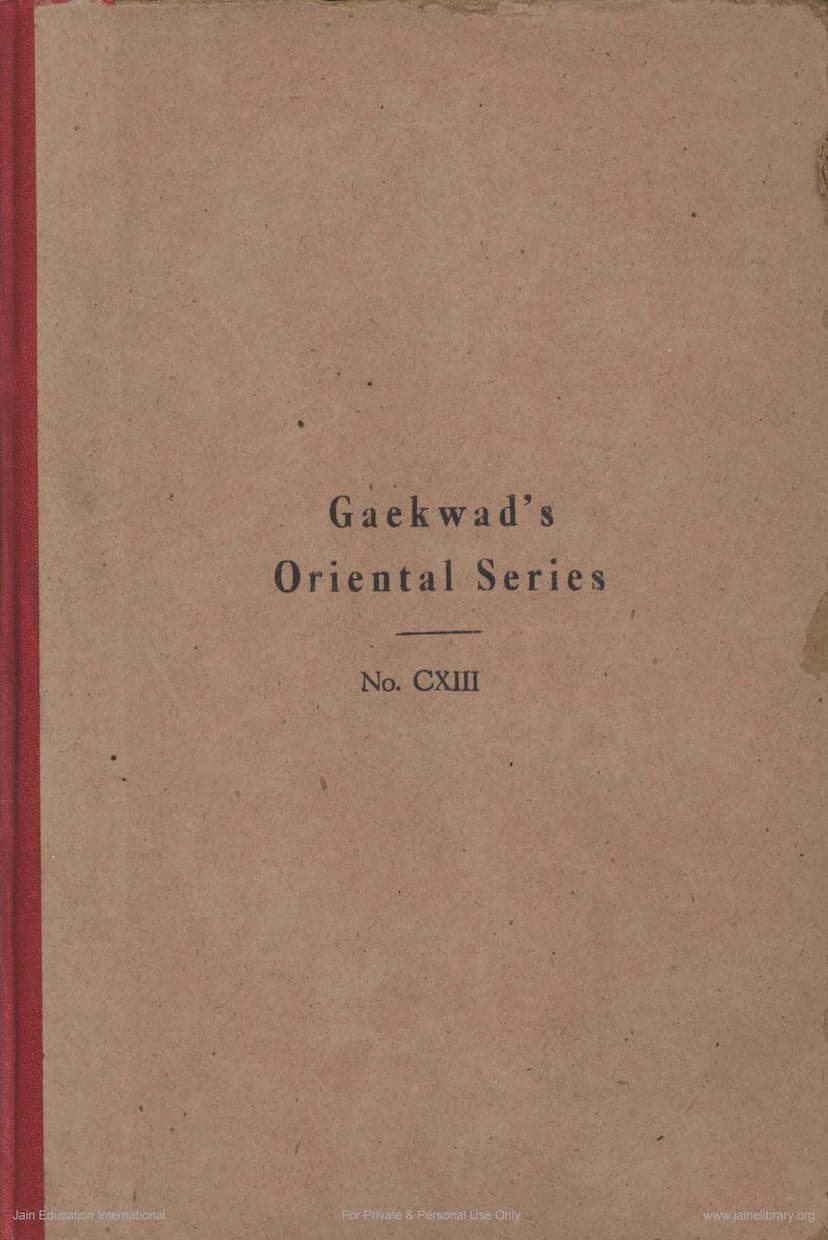Hetubindu Tika
Added to library: September 1, 2025

Summary
Here's a comprehensive summary of the Jain text "Hetubindu Tika" based on the provided pages:
Title: Hetubindu Tika of Bhatta Arcata, with the Sub-commentary entitled Aloka of Durveka Misra.
Publisher: Baroda Oriental Institute, 1949.
Authors:
- Dharmakirti: Author of the original Hetubindu text, a foundational work in Buddhist logic.
- Bhatta Arcata: Author of the Hetubindu-tika (commentary) on Dharmakirti's work. He was likely from Kashmir, a Brahman, and possibly later converted to Buddhism. His other names included Dharmakaradatta.
- Durveka Misra: Author of the Aloka (sub-commentary) on Bhatta Arcata's Hetubindu-tika. He was a student of Jitari, a professor at Vikramashila University, and likely a Maithila Brahman.
- Pandit Sukhlal Sanghavi and Muni Shri Jinavijayaji: Editors of this edition.
- B. Bhattacharya: General Editor of the Gaekwad's Oriental Series.
Core Subject Matter:
The text primarily focuses on Hetubindu, a treatise by Dharmakirti on the probans (hetu), which is a crucial element of inference in Indian logic. The Tika (commentary) by Arcata and the Aloka (sub-commentary) by Durveka Misra delve deeply into Dharmakirti's concepts, clarifying and elaborating on them.
Key Themes and Concepts Discussed:
- The Nature of Probans (Hetu): The Hetubindu and its commentaries analyze the definition of a valid probans, its essential characteristics, and its numerical limitations, proposing three types. The text explores the concept of vyapti (universal concomitance), its synonyms like sahacarya (co-existence), avyabhicara (non-deviation), and avinabhava (invariable concomitance).
- Buddhist Logic vs. Other Schools: The work engages in critical discussions with other Indian philosophical schools, particularly Nyaya-Vaisesika and Jaina logic, refuting their views on universal concomitance and the characteristics of a probans. The Buddhist stance, emphasizing the relations of identity of essence (tadamya) and cause-effect (tadutpatti) as determinants of universal concomitance, is contrasted with the broader relational understanding of other schools.
- Three Characteristics of a Probans: The text elaborates on the three essential characteristics of a probans: existence in the subject (paksha), existence in the homologue (sapaksha), and absence in the heterologue (vipaksa). It discusses the historical development of these concepts and refutes the views that propose five or six characteristics.
- Fallacious Reasons (Hetvabhāsa): While the Hetubindu itself might only mention fallacious reasons, the commentaries (especially in relation to the three characteristics) delve into their origin from the absence of these characteristics.
- Buddhist Doctrines: The Hetubindu and its commentaries also discuss core Buddhist philosophical concepts such as:
- The refutation of the doctrine of universals (jāti or samanyavada).
- The establishment of the doctrine of apoha (exclusion) as a substitute for universals.
- Absolute particularism or momentariness (kshanika).
- The doctrine of uncaused destruction (nirhetuka-vināsha-vada).
- Indeterminate perception (nirvikalpa) as the primary valid organ of knowledge, with determinate inference (anumana) having indirect validity.
- The relation of cause and effect (karya-karana-bhava).
- The nature of efficiency (sahakaritva).
- The nature of negation (abhava).
- Dharmakirti's Life and Work: The introduction provides biographical details about Dharmakirti, his education, his philosophical journey, his major works (like Pramānavarttika, Nyayabindu, Hetubindu), and his influence on subsequent Buddhist thought. It also touches upon the scholarly debates surrounding his chronological placement and the interactions with his contemporaries and predecessors.
- Commentarial Tradition: The text highlights the significance of the commentaries by Arcata and Durveka Misra in explaining Dharmakirti's profound and subtle ideas. Arcata's commentary is praised for its lucidity and depth, while Durveka Misra's sub-commentary is noted for its elaborate explanations and independent thinking, sometimes even disagreeing with his teacher, Arcata.
- Influence on Later Thought: The Hetubindu-tika by Arcata, in particular, is noted for its substantial influence on both Buddhist and non-Buddhist thinkers, including Jaina logicians who extensively utilized and refuted his arguments.
Critical Apparatus and Edition:
The edition details the manuscripts used for the Hetubindu-tika (S, a palm-leaf MS.) and its commentary Aloka (N, a paper MS., and P, photo-prints). It also discusses the collation with the Tibetan version (T) of the Hetubindu-tika for textual reconstruction and understanding. The introduction meticulously describes the challenges in deciphering and editing these ancient texts, acknowledging the contributions of various scholars and institutions in procuring and preparing the manuscripts.
Structure:
The table of contents indicates the text is divided into several sections:
- Hetubindu Prakaranam (The main text of Hetubindu)
- Hetubindu Tika (The commentary by Arcata)
- Hetubindu Tika Aloka (The sub-commentary by Durveka Misra)
- Appendices containing lists of philosophical terms, proper names, and quotations.
Overall Significance:
This publication is a scholarly edition of a significant work in Buddhist logic, providing access to the original commentary and sub-commentary, which are crucial for understanding Dharmakirti's influential treatise. The extensive introduction and critical apparatus offer valuable insights into the historical and philosophical context of these texts.